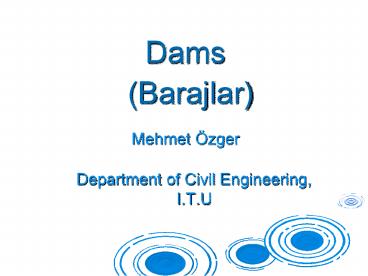Dams - PowerPoint PPT Presentation
Title: Dams
1
Dams
(Barajlar)
- Mehmet Özger
Department of Civil Engineering, I.T.U
2
What is a dam?
- A dam is a barrier built across a stream, river
or estuary to hold and control the flow of water
for such uses as drinking water supplies,
irrigation, flood control and hydropower
generation etc.
3
(No Transcript)
4
Negative impacts
- Imbalance of the ecosystem
- Decreased amount of downstream water
- Spreading of some water-born diseases
- Reduction in the fertility of farmlands
5
Purpose Distribution of Dams
Source International Commission on Large Dams
(ICOLD)
6
Worlds registered dams
Source International Commission on Large Dams
(ICOLD)
7
Parts of a dam
- Dam body Body forms the main part of a dam as
an impervious barrier - Reservoir It is the artificial lake behind a dam
body - Spillway is that part of a dam to evacuate the
flood water from reservoir. - Water intake structures is a facility to
withdraw water from a reservoir. - Sluiceway Gerektiginde baraj gölünü tamamen
bosaltmak, dolusavak kapasitesini azaltmak,
akarsu mansabina birakilacak suyu salmak amacina
yönelik tesisler. - Diversion facilities To redirect the streamflow
from construction area
8
Parts of Dams
Reservoir
9
Upstream
Reservoir
Dam body
Spillway
Downstream
10
Classification of Dams
- According to dams height
- If crest elevation and foundation level is
greater than 15 m then it can be considered as a
Large Dam. - If dam height is less than 15 m then Small Dam.
- If dam height is greater than 50 m then High Dam
11
Classification of dams
- Dams are classified on several aspects, some of
the important aspects are as follow - Based on Hydraulic Design
- Over flow dams (e.g. concrete dams)
- Non over flow dams (e.g. embankment dams)
- Based on Structural Design
- Gravity dams
- Arch dams
- Buttress dams
- Based on Usage of Dam
- Storage dams
- Diversion dams
- Detention dams
12
Classification of dams
- Based on Construction Material
- Concrete / Masonry dams
- Earthfill dams
- Rockfill dams
- Earthfill rockfill dams
- Concrete faced rockfill dams (CFRD)
- Based on Capacity
- Small dams
- Medium dams
- Large dams
13
3.3 Planning of Dams
- Three steps
- - Reconnaissance survey
- (infeasible alternatives eliminated)
- - Feasibility study
- - Planning study
14
3.3.1 FEASIBILITY STUDY
- A) Determination of water demand
- Estimate various types of demands through the
life time - B) Determination of water potential
- From available sources and available past data
- C) Optimal plans
- ? Check out the relation D versus S.
15
- D) Determination of dam site
- ? Factors should be taken into consideration
- Topography
- Geology and dam foundation
- (faults and weak geologic formations should be
avoided) - Type of soil affects the overall stability of dam
body - Available of construction materials
- Flood hazard
- Seismic hazard
- Spillway location and possibilities
- Construction time
- Climate (earth fill dam is not appropriate for
rainy climates) - Diversion facilities
- Sediment problem
- Water quality
- Transportation facilities
- Right of way cost
16
e) Determination of dam location
- Characteristics of dam location
- Geologic formation
- Spillway location and capacity
- Diversion conditions
- Sediment condition
- Transportation facilities
- Structural design
- Availabilty of meterials
17
- f) Project design
- ? involves the computation of dimensions of the
dam. - 1. Hydrologic design (max. lake elevation
spillway cap. crest elevation) - 2. Hydraulic design (static dynamic loads
spillway profile outlet dimensions) - 3. Structural design (stress distribution
required reinforcement)
18
- Failure of the dam ? Dam Break
- It is rapid for a concrete dam. See the
textbook for the examples.
19
(No Transcript)
20
(No Transcript)
21
3.3.2 PLANNING STUDY
- ? Followings need to be done, since dimensions
are already determined - Topographic surveys (15000 scaled map)
- Foundation study (seepage permeability, bearing
capacity etc. tests) - Materials study (quantity of materials)
- Hydrologic study (measurements of hydrologic
parameters) - Reservoir operation study (is to be performed
periodically)
22
3.4 Construction of Dams
- Four principal steps are followed during the
construction - 1) Evaluation of Time Schedule and
Equipments - ? a work schedule is prepared using CPM.
- 2) Diversion
- ? before the construction, river flow must be
diverted from the site - see the below figure for two possible ways to
divert water
23
(No Transcript)
24
- 3) Foundation Treatment
- ? Concrete Rock-fill dams ? hard formations
- Earth-fill dams ? most of soil conditions
- ? Highly porous foundation ? excessive seepage,
uplift, settlement - Grouting Operation is applied to solidify the
foundation - to reduce seepage
25
- 4) Formation of the Dam Body
- For Concrete Gravity dams
- ? Low-heat cements ? to reduce shrinkage problem
- ? Concrete is placed in blocks
26
- Keyways are built between sections to make the
dam act as a monolith
27
- Waterstops are placed near upstream face to
prevent leakage
28
(No Transcript)
29
(No Transcript)
30
(No Transcript)
31
(No Transcript)
32
(No Transcript)
33
(No Transcript)
34
(No Transcript)
35
(No Transcript)
36
(No Transcript)
37
(No Transcript)
38
(No Transcript)































